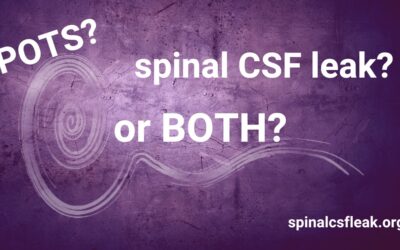
Orthostatic headache, or headache that is worse when upright, is a key feature of intracranial hypotension due to spinal CSF leak, but is also a common feature in patients with postural orthostatic tachycardia syndrome (POTS). Getting the correct diagnosis is important to target treatment appropriately. In practice we see patients misdiagnosed with one or the other, but many patients have BOTH.
This new publication is a small sample size but is important nonetheless.
These Swiss authors did autonomic function testing on patients with spontaneous intracranial hypotension (SIH) and compared them with control patients with POTS (postural orthostatic tachycardia syndrome). POTS is a type of autonomic dysfunction defined in adults as a clinically symptomatic heart rate (HR) increase of more than 30 beats per minute (bpm) or an increase in HR to ≥ 120 bpm within 10 min of standing or head-up tilt (HUT), in the absence of orthostatic hypotension. Both POTS patients and SIH patients have “orthostatic intolerance” which means that they have difficulty maintaining upright posture due to symptoms that are worse when upright.
They found that ALL of the patients with proven SIH due to spinal CSF leak met the diagnostic criteria for POTS. So all patients had BOTH. All SIH patients had orthostatic headache compared with 27% of the POTs patients.
This is important because patients with SIH may be diagnosed with POTS without further evaluation for a spinal CSF leak. The authors are suggesting that patients with prominent orthostatic (positional) headache should be evaluated for intracranial hypotension due to a spinal CSF leak even if they meet the diagnostic criteria for POTs.
A larger sample size is needed to confirm the findings. This topic will be discussed at the Second Annual Cedars-Sinai Intracranial Hypotension Symposium on October 13, 2018.
Clinical symptoms and results of autonomic function testing overlap in spontaneous intracranial hypotension and postural tachycardia syndrome – a retrospective study
Nina Graf, Ana Mafalda Fernandes Santos, Christian T Ulrich, Christian Fung, Andreas Raabe, Jürgen Beck, Werner J Z’Graggen
Cephalalgia Reports – First Published May 9, 2018
Abstract
Background and purpose:
Orthostatic headache is a hallmark of patients with spontaneous intracranial hypotension (SIH) but may also occur in patients with postural tachycardia syndrome (POTS). Our aim was to compare the clinical symptoms and findings of autonomic function testing in patients with SIH and POTS.
Methods:
This was a retrospective analysis of the clinical symptoms and findings of autonomic function testing, including sympathetic vasoconstrictor and parasympathetic cardiac function as well as head-up tilt in patients with SIH and POTS.
Results:
Nine patients with confirmed SIH and 48 with POTS (neuropathic N = 35, hyperadrenergic N = 5, deconditioned N = 8) were included. SIH patients experienced on average a shorter disease duration than patients with POTS. Orthostatic headache was present in all patients with SIH and 27% of patients with POTS. There was a broad overlap of other clinical symptoms of orthostatic intolerance. Screening autonomic function testing revealed normal sympathetic and parasympathetic function in all patients. All patients with SIH showed an excessive clinically symptomatic heart rate increase during standing, fulfilling the diagnostic criteria for POTS.
Conclusion:
Clinical symptoms and results of autonomic function testing overlap in SIH and POTS. Hence, patients with prominent orthostatic headache fulfilling the diagnostic criteria for POTS should also be evaluated for further testing of a spinal cerebrospinal fluid leak, in the absence of a history of lumbar puncture.
http://journals.sagepub.com/doi/abs/10.1177/2515816318773774
